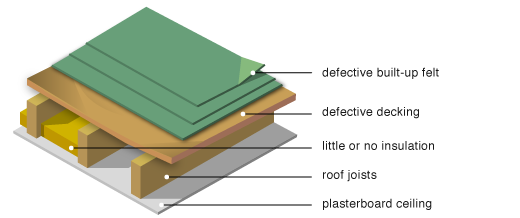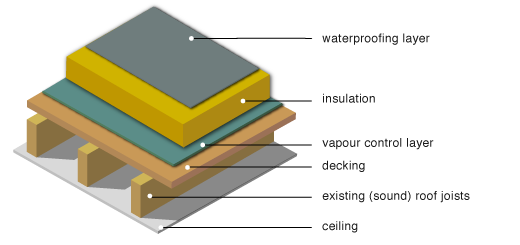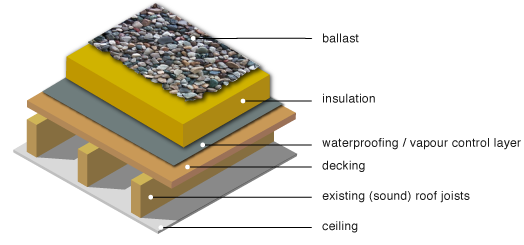• Though a very convenient form of construction, even the development of better roofing technologies has not prevented flat roofing from continuing to be prone to traditional defects such as leakage, component decay and, in the more extreme cases, structural failure. Millions of pounds a year are spent on the refurbishment of flat roofing – from simply patching, re-coating / re-covering through to the more comprehensive stripping off and replacement of the entire roof.
• Where confronted with the possibility of radical roof refurbishment, it might be wise to consider replacement with a pitched roof.

Prevention of condensation
• Along with leakage, flat roofs, particularly domestic scale timber roofs, are notoriously subject to the effects of condensation. A proper understanding of the link between thermal performance, air leakage and condensation is important to the successful design of a flat roof.
• Condensation occurs where warm moisture-laden air comes into contact with a cold surface. In the case of a flat roof, moist warm air rises from the room below into the roofing fabric where, it risks condensing on the underside of the roof decking/ water-proof membrane.

ceiling mould caused by condensation
• Part of the successful design of a flat roof is in preventing such a condition from occurring. The choice of construction theoretically rests on two different methods of handling the moist air:
- in traditional flat roof construction, the moist air is prevented from penetrating the roof fabric through the use of a vapour control layer at ceiling level. Any residual water vapour entering the roof dispersed through cross-ventilation provided by eaves vents or proprietary ‘mushroom’ vents projecting through the roof – aka a ‘cold roof’
- more recent design practice is to inhibit the moist air from condensing by keeping the roof deck at near room temperature through insulation and preventing water vapour from penetrating further by provision of a vapour control layer (VCL) above the deck - a 'warm roof'. Condensation might still occur under a thin deck, particular in the case of an ‘inverted’ warm roof where rain run-off can lead to rapid cooling, but can be averted by internal temperatures and / or the use of a deck material with a high thermal capacity.
• In practice, because of the loss of heat and relative difficulty of providing adequate ventilation, ‘cold’ roof construction has largely been discontinued and in Scotland, banned.
Types of flat roof
Warm roof

• The roof deck is kept warm through placing the insulation above it. The waterproof covering is above the insulation and the vapour control layer is placed below the insulation.
Inverted warm roof

• In an inverted warm roof the insulation is placed above a combined VCL / waterproofing membrane. The insulation effectively ‘protects’ the roof membrane from thermal stress, UV light and mechanical damage. The insulation is preventing from lifting by adding ballast.
Cold roof (not recommended)

• The insulation is placed below the roof deck. Any moist air penetrating the roof is dispersed through ventilation between the insulation and the underside of the deck.
Refurbishment and insulation

Types of refurbishment
Depending on the condition of the existing roof, various permutations are available, including:
• Overlay: appropriate where the existing deck is sound and where the waterproof membrane is aged. Either a new membrane is placed over the existing complete with insulation and ballast (inverted warm) OR the existing membrane is prepared as a vapour check and insulation is added complete with a waterproof membrane over (warm).
• Total renewal: appropriate where the existing deck and roofing system has failed. The deck and waterproof membrane is stripped and replaced new decking and roofing system (warm or inverted warm as shown below)
NB
• The flat roof renewal methods described below are for general guidance only. The performance of products and methods of fixing vary. When specifying, confirm with the product manufacturer their installation methods and expected performance.
Design considerations
Following a detailed inspection of the existing roof, the following design factors should be established:
• The required u-value of the roof.
• The extra loading to the existing roof structure from additional insulation / ballast / traffic / equipment both during and after construction.
• The required compressive strength of the insulation where permanent plant or equipment is located upon the roof surface.
• The required fire resistance.
• Check condensation risk (see BS 6229:1982 and BS 5250: 2002 for guidance)
• Determine method of adhesion / fixing / ballasting
• Fall requirements
• Any particular acoustic requirements
Existing 'cold' roof (with failed deck and roof covering)

New 'warm' roof

New 'inverted warm' roof

Components
It is important to design the roof in collaboration with the manufacturers of the construction components to ensure compatibility, correct sizing and fixing to avoid premature failure of the roofing system.
Deck
• Orientated Strand Board (OSB): Thickness should be determined by span, type of insulation and membrane, but the minimum thickness should be 18mm. The OSB panels should be manufactured to BS EN300 and be certified by BBA or WIMLAS.
• Plywood: should conform to BS5268 Part 2 and to BS EN 636 Part 3. Under the APA certification scheme, quality grades should be C-D and C-C.
• Timber boarding: should be t&g with a minimum thickness of 25mm.
Vapour control layer
In warm roof construction, the VCL should always be located on the warm side of the insulation. The material specified should be a metal-foil laminated polyethylene or reinforced bitumen sheet. All penetrations of the VCL should be sealed, and the membrane turned up to all vertical surfaces by the thickness of the insulation.
Insulation
The correct choice of insulation is important when adhering the waterproofing, particularly where solvent-based adhesives are used.
Roof membrane / covering
Single ply membrane: EPDM or TPO membranes can be either loosely laid or fixed directly to the deck. These membranes can be quickly installed and are easy to repair – they can also be re-used, but only if they have not been mechanically fixed. See also: ‘Whole life costing – Single ply membranes’ for more information.
Built-up felt: Reinforced Bitumen Membranes should comprise of polyester fibre-based bitumen sheets tested to BS EN 13707. Guidance to suitability of material application is provided by BS 8747. See also: ‘Durability – High performance roofing’ for more information (though please note ref. to BS 747 has now been replaced by BS 8747)
Polymer modified mastic asphalt: Mastic asphalt should be applied in accordance with BS 8218 and BS 8000: Part 4. Isolating layers should be used below and above & below the asphalt as required. When used as the finished surface to the roof, consideration should be made to reducing solar gain through solar reflective paint or chippings / aggregate / paving tiles / slabs.
Ballast
Ballast is usually required in the construction of ‘inverted’ warm roofs to prevent the insulation boards from being lifted by high winds or floating as water drains from the roof. It normally consists of graded pebbles or concrete paving slabs.
Filter membrane
Though not vital, a filter membrane can be used in the build-up of an inverted warm roof. Located between the insulation and the ballast, it can prevent grit being washed down to the waterproof layer where it may damage the membrane or block outlets.
U-values for timber flat roofs
U-value target
EST CE 189 cites a target for the u-value of flat roof as being 0.20 W/m2K, though much higher values are achievable. Check expected u-values with the insulation manufacturer.
Typical U-values of 'warm' and 'inverted warm' constructions
| Insulation thickness (mm) | U-value W/m2K |
| Mineral wool slab (adhered / mechanically fixed)* | |
| 150 | 0.22 |
| 200 | 0.17 |
| 250 | 0.15 |
| PUR fully-bonded** | |
| 100 | 0.22 |
| 130 | 0.18 |
| 150 | 0.16 |
| PIR fully bonded *** | |
| 100 | 0.25 |
| 150 | 0.18 |
| 200 | 0.14 |
| Extruded polystyrene (XPS) fully-bonded* | |
| total depth of fill (mm) | |
| 110 | 0.23 |
| 150 | 0.19 |
| 200 | 0.14 |
Sources: *Knauf; **Kingspan; ***Celotex;
Publications
Building Research Establishment (BRE)
• Thermal Insulation: Avoiding Risks, C.Stirling, BRE Press, 2001
• Installing Thermal Insulation, BRE Press, 2006
• A list of publications relating to flat roofing (.doc download)
Standards
British Standards Institute (BSI)
• British Standards associated with the insulation of flat roofs (.doc download)
Further information
• Flat roof coverings compared
• Insulation materials compared
• Flat roofing alliance
• Mastic Asphalt Council
• National Insulation Association
• British Urethane Foam Contractors Association
 Flat roof insulation products on GreenSpec
Flat roof insulation products on GreenSpec
Disclaimer
GreenSpec accepts no responsibility or liability for any damages or costs of any type arising out of or in any way connected with your use of this web site. Data and information is provided for information purposes only, and is not intended for trading purposes. Neither GreenSpec nor any of its partners shall be liable for any errors in the content, or for any actions taken in reliance